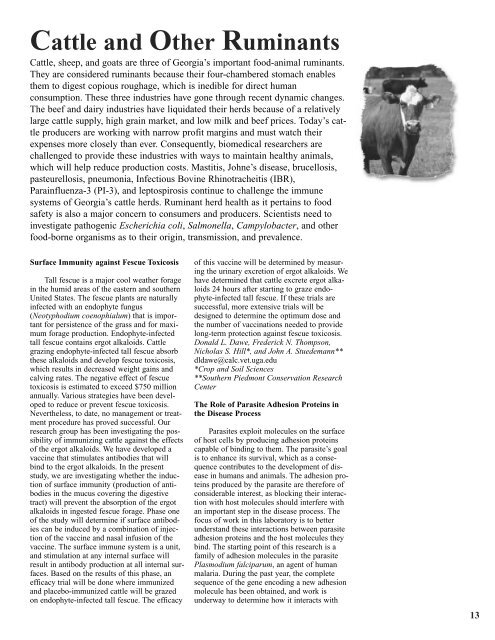M E S '9 8 - University of Georgia College of Veterinary Medicine
M E S '9 8 - University of Georgia College of Veterinary Medicine
M E S '9 8 - University of Georgia College of Veterinary Medicine
- No tags were found...
You also want an ePaper? Increase the reach of your titles
YUMPU automatically turns print PDFs into web optimized ePapers that Google loves.
Cattle and Other RuminantsCattle, sheep, and goats are three <strong>of</strong> <strong>Georgia</strong>’s important food-animal ruminants.They are considered ruminants because their four-chambered stomach enablesthem to digest copious roughage, which is inedible for direct humanconsumption. These three industries have gone through recent dynamic changes.The beef and dairy industries have liquidated their herds because <strong>of</strong> a relativelylarge cattle supply, high grain market, and low milk and beef prices. Today’s cattleproducers are working with narrow pr<strong>of</strong>it margins and must watch theirexpenses more closely than ever. Consequently, biomedical researchers arechallenged to provide these industries with ways to maintain healthy animals,which will help reduce production costs. Mastitis, Johne’s disease, brucellosis,pasteurellosis, pneumonia, Infectious Bovine Rhinotracheitis (IBR),Parainfluenza-3 (PI-3), and leptospirosis continue to challenge the immunesystems <strong>of</strong> <strong>Georgia</strong>’s cattle herds. Ruminant herd health as it pertains to foodsafety is also a major concern to consumers and producers. Scientists need toinvestigate pathogenic Escherichia coli, Salmonella, Campylobacter, and otherfood-borne organisms as to their origin, transmission, and prevalence.Surface Immunity against Fescue ToxicosisTall fescue is a major cool weather foragein the humid areas <strong>of</strong> the eastern and southernUnited States. The fescue plants are naturallyinfected with an endophyte fungus(Neotyphodium coenophialum) that is importantfor persistence <strong>of</strong> the grass and for maximumforage production. Endophyte-infectedtall fescue contains ergot alkaloids. Cattlegrazing endophyte-infected tall fescue absorbthese alkaloids and develop fescue toxicosis,which results in decreased weight gains andcalving rates. The negative effect <strong>of</strong> fescuetoxicosis is estimated to exceed $750 millionannually. Various strategies have been developedto reduce or prevent fescue toxicosis.Nevertheless, to date, no management or treatmentprocedure has proved successful. Ourresearch group has been investigating the possibility<strong>of</strong> immunizing cattle against the effects<strong>of</strong> the ergot alkaloids. We have developed avaccine that stimulates antibodies that willbind to the ergot alkaloids. In the presentstudy, we are investigating whether the induction<strong>of</strong> surface immunity (production <strong>of</strong> antibodiesin the mucus covering the digestivetract) will prevent the absorption <strong>of</strong> the ergotalkaloids in ingested fescue forage. Phase one<strong>of</strong> the study will determine if surface antibodiescan be induced by a combination <strong>of</strong> injection<strong>of</strong> the vaccine and nasal infusion <strong>of</strong> thevaccine. The surface immune system is a unit,and stimulation at any internal surface willresult in antibody production at all internal surfaces.Based on the results <strong>of</strong> this phase, anefficacy trial will be done where immunizedand placebo-immunized cattle will be grazedon endophyte-infected tall fescue. The efficacy<strong>of</strong> this vaccine will be determined by measuringthe urinary excretion <strong>of</strong> ergot alkaloids. Wehave determined that cattle excrete ergot alkaloids24 hours after starting to graze endophyte-infectedtall fescue. If these trials aresuccessful, more extensive trials will bedesigned to determine the optimum dose andthe number <strong>of</strong> vaccinations needed to providelong-term protection against fescue toxicosis.Donald L. Dawe, Frederick N. Thompson,Nicholas S. Hill*, and John A. Stuedemann**dldawe@calc.vet.uga.edu*Crop and Soil Sciences**Southern Piedmont Conservation ResearchCenterThe Role <strong>of</strong> Parasite Adhesion Proteins inthe Disease ProcessParasites exploit molecules on the surface<strong>of</strong> host cells by producing adhesion proteinscapable <strong>of</strong> binding to them. The parasite’s goalis to enhance its survival, which as a consequencecontributes to the development <strong>of</strong> diseasein humans and animals. The adhesion proteinsproduced by the parasite are therefore <strong>of</strong>considerable interest, as blocking their interactionwith host molecules should interfere withan important step in the disease process. Thefocus <strong>of</strong> work in this laboratory is to betterunderstand these interactions between parasiteadhesion proteins and the host molecules theybind. The starting point <strong>of</strong> this research is afamily <strong>of</strong> adhesion molecules in the parasitePlasmodium falciparum, an agent <strong>of</strong> humanmalaria. During the past year, the completesequence <strong>of</strong> the gene encoding a new adhesionmolecule has been obtained, and work isunderway to determine how it interacts with13

















